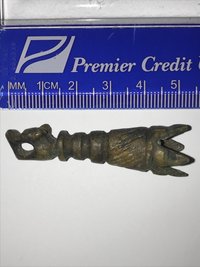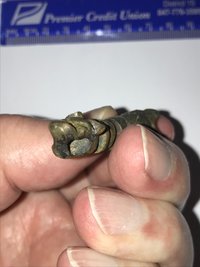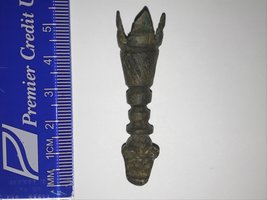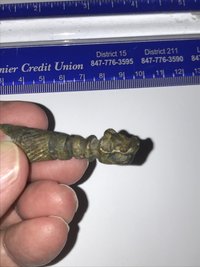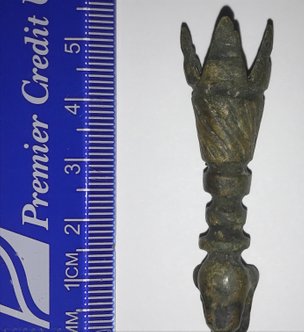Viking drinking horn final
Drinking horn finals from the early medieval period are extremely rare. Let aside, those having an outspoken viking (or hybrid Anglo-)Scandinavian style as the example here published. This bronze example had been found near Lincoln in Lincolnshire, England.
The, complete, example seemingly having a simple form of decoration and casting, but, and here one recognizes the distinguished, and what it sets it apart from everything else, viking art, once again, zooming in, taking a closer look. The details are of an astonishing quality - and if I might say: force. Looking at the end of the final where one sees an animal face, a slight rotation of it unravels the intimate perspective looking at a wolves head.
The form of the wolve head is in its design Anglo-Scandinavian, but has a more refined casting than the average Anglo-Scandinavan style, linking him directly towards the true Borre style. If we look on top of the head, the head transformates another kind of animal head: that of a bear with rounded ears. Seen from a position when holding the final with the head to the right, the image almost becomes fierceful, dragon - or lion - like, like the head on the stern of a 'drakkar' ship. The different images of faces is a very feature of the art of the vikings. From every angle another new image unfolds.
I'm researching if similarlike type of drinking horn finals are known, either from England or outside. In the Portable Antiques Scheme, no similarlike examples are known until now, let aside, types wich even vaguely coming near a true viking or (Anglo-)Scandinavian origin for style and decoration. A lot of types are typologized as Anglo-Saxon, medieval, a few with romanesque features, and some from the Roman or Iron Age. But literally no one from the Viking Age. A vaguely similar but more decorated example, found in Scotland, can be seen on Pinterest.
Carol Neuman de Vegvar, living in the United States, once visited me studying another drinking horn final, of presumably Irish or Anglo-Scandinavian origin, considering its seize and decoration. She is working on an overall publication o early medieval drinking horn finals. I have asked here if she ever came across a similarlike type like the one discussed here.
I was wondering how such a finial would have been attached towards the drinking horn. First, possibly naivly, thinking of something like glue, the curator of museum Dorestad pointed out to me that very likely the finial was made to fit the horn, instead of the other way around. The triangular endings would have been bend and entangled on the ending of the horn.
All in all I am very lucke for having aquired a third drinking horn final of the early medieval period. The third one can be seen here.
Well. I could have been with these stones until after dark, but as my wife wanted to travel on.. well.. I see you again, some day, hogback stones from Gosforth. And if you happen to be there one day, do not forget that monument on the outside...
Further on with the Cumbrian hogbacktour !
In - yes, luckily again in - St. Peter's church in Heysham, there is a truly beautiful hogback stone. The guide told us, it had been studyied by Thor Ewing, a writer, in 2000. in 'Understanding the Heysham hogback' A tenth century sculpted stone monument and its context (link), Thor Ewing tells in detail what he dicovered on the both sides of this hogback stone.
Just being brought in the church as late as the 1970's accompanied with some protest here and there among the church visitors, considered as being a token of old paganism, it had been remarkably nice preserved, and a lot of detail can be seen, still. Truly worthwile a visit.
I had a small debate with the guide in the church if the - zoomorphic, in my opinion - faces on the sides were lions (or hippo's). The guide doubted if the vikings could have known about lions. Well I guess so, concerning the runes on the Ancient Greek lion statue at the Arsenal, Venice. For example. Vikings did travel south..
But when he told me he was doubting the vikings 'discovered' (as the native inhabitants were of course, in the first place) America before Columbus, I decided to rest my case..
One has to know when to start and to end a conversation ..
Just discovered the book in a bookstore written by Geoff Holder - The guide to the mysterious Lake District, I knew there had to be another hogback stone in Lowther, St. Micheal's Church. With a promising image described in the text of 'a naval and a land-based force of shield-bearing vikings above a fish and what might be a coiled sea serpent. On the reverse is a row of female figures with snakes, possibly a representation of the hideous hag Hel'. Wow. If that did not sound as a true pagan promised land ..
Not complaing too much after all we have seen, this visit was the dissapointing one of them all. But if you wife states 'I am happy to have seen them' and I am answering 'Measuring is knowing' and the even more obligate verb 'handling 'if we did not see it at all, we wouldn't have known anything at all of how they were looking' the glass was again half full, at the last day of our journey..
The hogback stone appeared to be just being tolerated within the entrance segment part of the church. As something you never use anymore but you do not throw away - entirely. That sort of feeling emerged when seeing this hogback asylum seekers.. Bed, bath and bread, ás we say in Dutch, but no luxury at all and standing on some outcuts of wood, you would balance the table with at home..
Come on, St. Micheal's Church.. care a bit more of your 'children' !
This hogback stone was moved in the church in 1907. Hogback stones layed partially buried in the churchyard before it was dug up and moved into the church.
The promising depiction of a longship - as certainly can be seen after some studying - see http://vikingminds.co.uk/pages/longship
we have missed !
The stone itself is (157 x 50 x 30 cm) and very worn.
The hogback stones in Cumbria - very diverse in quality, but everyone worth a visit ! Especially on a gloomy day in late October ...
The churches to visit - see photos of resp. St. Andrew's church in Penrith, St. Mary's church in Gosforth, St. Peter's church in Heysham and St. Micheal's church in Lowther.
Did I miss out on another one in Cumbria ? Let me know !
In a next blog I will take you to four - still remaining utterly mysterious- statues 'guarding' the graveyard of St. Andrew's church in Dacre..
For the last blog of October 9th see this link.
References: (as always, links to where the books can be ordered are attached).
Edwards, B.J.N. Vikings in North West England - The artifacts (1998);
Emery, Gordon, CURIOUS CUMBRIA, The Lake District & Beyond: A celebration of Cumbria (2023)
Ewing, T. 'Understanding the Heysham hogback' A tenth century sculpted stone monument and its context ;
Hall, R. Viking Age archaeology in Britain and Ireland (first printed 1990, reprinted with amendments in 1995);
Holder, G. The guide to the mysterious Lake District (2009)
possibly also (as there within the part of Cumbria dealing with Carlisle, the Eden Valley, Barrow-in-Furness, Whitehaven and the west coast is being dealed with)
Holder, G. Paranormal Cumbria (2010)
http://vikingminds.co.uk/pages/longship
